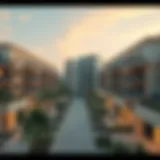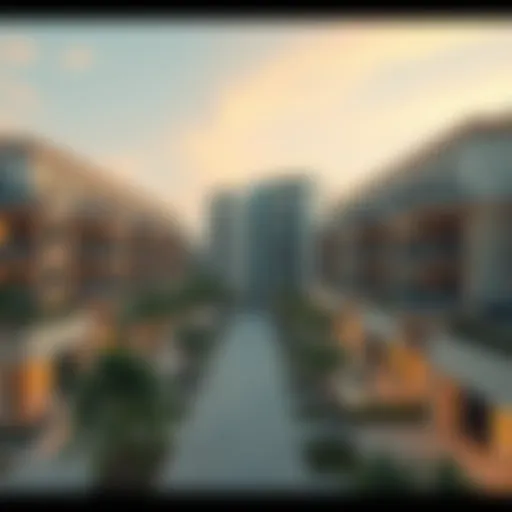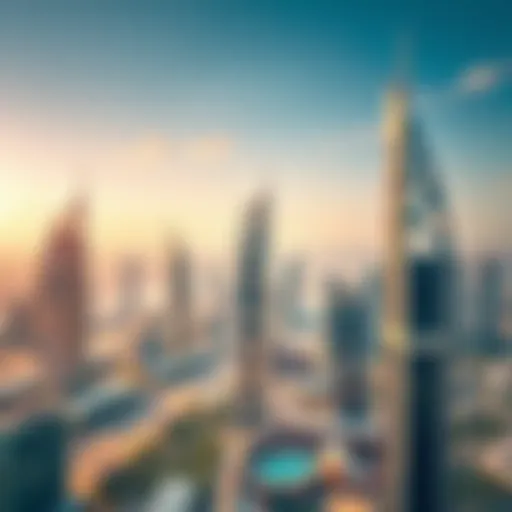Tiger Building in Dubai: Architectural Marvel and Impact
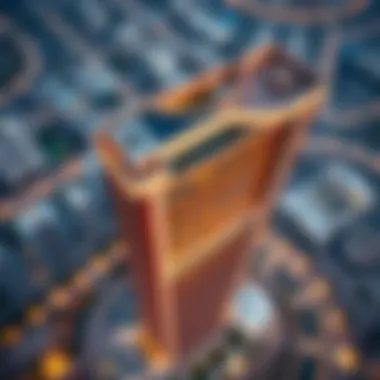
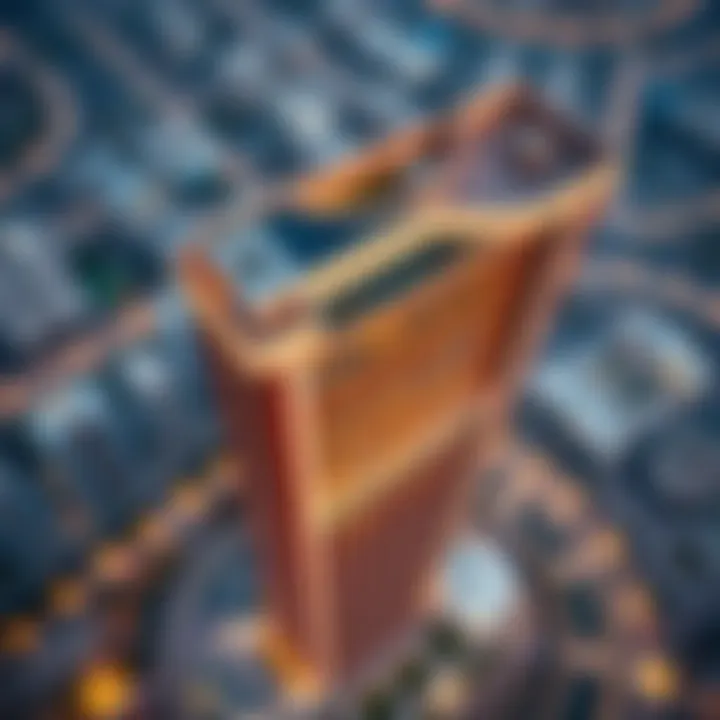
Intro
In the sprawling landscape of Dubai, where architectural wonders seem to touch the sky, the Tiger Building stands out as a beacon of modern design and ambition. Nestled within the city's ever-expanding skyline, this building isn't just another structure; it represents a turning point in the architectural narrative of Dubai. With its impressive facade and multifaceted design elements, the Tiger Building has carved a niche that appeals not only to investors but also to architects and lifestyle enthusiasts alike. This piece aims to delve into the heart of this architectural marvel, shedding light on its significance, construction intricacies, and its broader role in shaping Dubai's real estate scene.
Market Trends
As we continue to witness rapid changes in Dubai's property market, understanding the current trends is paramount for anyone interested in investing or forming a sophisticated perspective on urban development.
Current Market Analysis
Dubai’s market is not for the faint-hearted. It’s a dynamic ecosystem influenced by various factors such as global economic shifts, tourism, and policy changes. Lately, we can observe a noteworthy uptick in both residential and commercial properties, signaling a resurgence in investor confidence. Areas that were once less favored are now experiencing revitalization, driven partially by developments like the Tiger Building. People are now looking for more than just square footage; they seek lifestyle, accessibility, and sustainability.
- Demand for Mixed-Use Spaces: Increasingly, investors are gravitating toward properties that blend residential, commercial, and leisure facilities. This shift aligns perfectly with the multifunctional layout of the Tiger Building.
- Role of Technology: Smart buildings are gaining traction, as the integration of technology into architectural frameworks becomes a selling point. Aspects like energy efficiency and smarter living solutions are likely to be appealing to future buyers.
Future Predictions
So, where is the tiger headed? Analysts suggest a sustained growth path, but with a few shifts in focus:
- Sustainability Over Aesthetics: As climate awareness rises, buildings designed with sustainability will be at the forefront.
- Integration of AI: The use of Artificial Intelligence for building management systems might soon become standard practice.
- Expatriate Interest: With a steady influx of professionals moving to the city, there will continue to be a demand for contemporary living spaces that cater to expatriates.
In this volatile market, those with their fingers on the pulse can find lucrative opportunities. As trends evolve, staying informed is key to successful investing.
“A smart investor understands the rhythm of the market—not just the numbers, but the motivations that drive them.”
Investment Insights
Gaining a foothold in Dubai's real estate sector isn't as insurmountable as it may seem, provided you know where to look. Understanding the landscape is crucial to making informed choices.
Best Areas for Investment
While the Tiger Building itself is a key player, several nearby locales showcase favorable characteristics for investors:
- Downtown Dubai: Continues to attract buyers and tenants with its luxury offerings and iconic views.
- Dubai Marina: Known for its vibrant lifestyle, this area is a hotspot for both short-term rentals and long-term investments.
- Dubai Creek Harbour: Emerging as a strong contender for residential investments due to its unique vision and planned infrastructure.
Tips for First-Time Investors
Venturing into Dubai's real estate market can be daunting, but these pointers may ease the navigation:
- Conduct Thorough Research: Knowledge is power, and in real estate, understanding local trends is imperative.
- Use Professional Guidance: Engage with real estate agents who have a local presence and expertise in the Tiger Building and surrounding locales.
- Consider Long-Term Potential: Look beyond immediate gains; assess the entire growth trajectory of the developments in your sights.
In summary, the Tiger Building encapsulates more than just bricks and mortar; it symbolizes a vital component in understanding Dubai's ever-evolving facade. For investors and enthusiasts looking to step onto this vibrant scene, keeping a close eye on market dynamics is an undeniable advantage.
Overview of Tiger Building
Importance of the Overview
The Tiger Building stands out in Dubai's architectural landscape, embodying a blend of innovation, functionality, and cultural resonance. Understanding its significance helps frame the larger discussions around urban development in this rapidly evolving city. This overview serves as the foundational platform on which the insights about its design, economic implications, and community interactions rest. With its unique structure and strategic placement, the building not only contributes to the skyline but also plays a critical role in shaping the local real estate market and the identity of modern Dubai.
Prelude to Tiger Building
The Tiger Building is a marvel that represents a fusion of traditional and contemporary architectural concepts. Completed in recent years, it stands as a testament to Dubai’s skyline ambition, which consistently evolves through groundbreaking constructions. This building, stemming from an impressive design philosophy, significantly contributes to the city’s aesthetic. In a landscape dominated by the extravagant and the avant-garde, the Tiger Building makes its own distinctive mark while still adhering to the principles of utility and sustainability.
It is more than mere concrete and steel; it encapsulates the dreams of a community and the aspirations of investors looking for prolific opportunities in one of the most dynamic markets in the world. This section sets the tone for a deeper exploration into what draws people towards this architectural feat.
Location and Accessibility
Strategically located, the Tiger Building holds prime real estate in Dubai. Situated in the heart of one of the city’s bustling districts, it benefits from unparalleled accessibility. Major thoroughfares and public transport systems converge nearby, facilitating easy movement for residents, visitors, and potential investors.
- The proximity to key locations, such as business hubs and entertainment centers, adds to its appeal.
- Nearby educational institutions and health facilities make it an attractive habitat for expatriates and families.
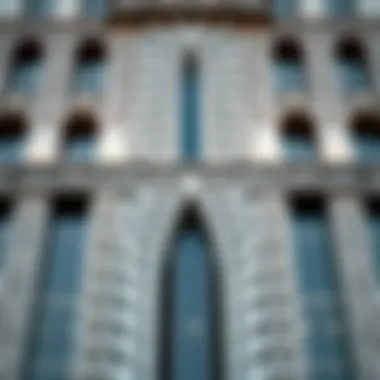
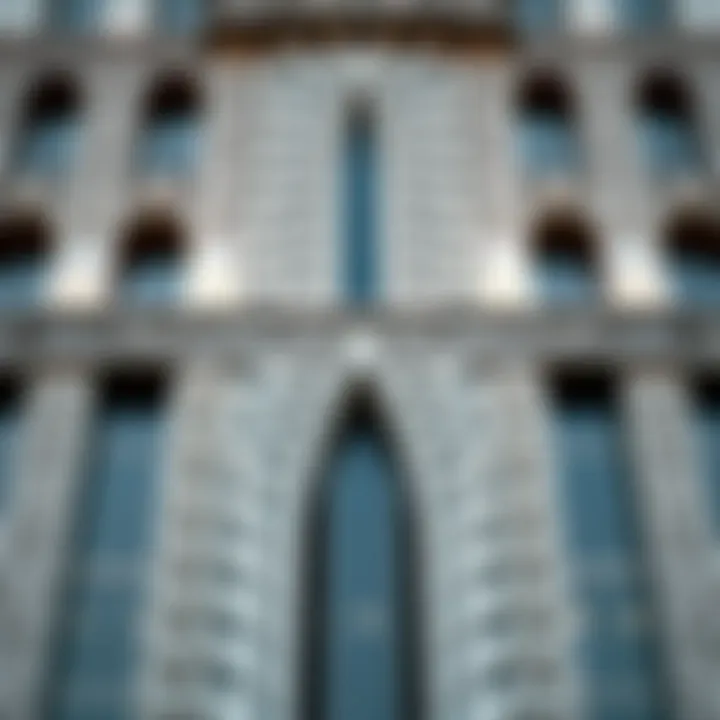
Being well-connected is crucial, especially for businesses aiming to thrive. This accessibility enhances the potential for foot traffic and commercial success, which is a major consideration for anyone interested in the real estate market. Therefore, understanding the positioning of the Tiger Building is vital not just from a residential aspect but also as a backbone of economic ambitions in the area.
“In the world of real estate, location is everything. The Tiger Building exemplifies this notion, standing proud at the intersection of convenience and opportunity.”
In summary, the Overview of Tiger Building sets a comprehensive stage for further discussion on architectural features, economic implications, and cultural significance. This groundwork is essential for various stakeholders— from investors and agents to homeowners— to recognize the building's multifaceted impact in Dubai's landscape.
Architectural Features
The architectural features of the Tiger Building represent a unique intersection of innovation and practicality. In a city known for its architectural wonders, it stands as a testament to the creative vision of its designers. A comprehensive exploration of these features reveals not only their aesthetic appeal but also their functional significance.
Design Philosophy
The design philosophy behind the Tiger Building is grounded in the need to harmonize beauty with functionality. The architects envisioned a structure that would serve as a beacon of modernity while respecting the cultural nuances of Dubai. One can see how the building’s flowing lines and sweeping curves mimic the natural landscapes surrounding it. Such design speaks to a greater narrative—bridging the gap between urban development and environmental consciousness.
The layout is thoughtfully engineered to maximize natural light while ensuring optimal energy efficiency. Large glass windows punctuate the facade, not just as architectural statements, but as features that invite sunlight into workspaces and common areas. This conscious choice enhances the quality of life within the building, creating a soothing and liberating atmosphere for its occupants. The design merges contemporary elements with traditional motifs, reflecting the cultural hybridity of Dubai itself.
Sustainability Practices
Sustainability is not just a buzzword in today’s architectural discourse; it’s a necessity that the Tiger Building embraces wholeheartedly. The construction and operational practices are designed to minimize environmental impact. Features such as rainwater harvesting systems and energy-efficient HVAC units illustrate a commitment to responsible building practices.
Key sustainability features include:
- Solar panels: Generating clean energy, reducing reliance on traditional power sources.
- Green roofs: These not only provide insulation but also enhance biodiversity.
- Smart lighting controls: Adjusting lighting based on occupancy, minimizing energy wastage.
The ethos of sustainability transcends just energy use; it extends to the materials chosen for construction. By prioritizing local resources, the building also lessens its carbon footprint associated with transportation. Overall, the sustainability practices adopted here serve as a forward-thinking model for future developments in urban environments.
Materials and Construction Techniques
When it comes to construction, the materials and techniques employed in the Tiger Building are nothing short of remarkable. Every component has been selected not only for its strength and durability but also for its visual impact. High-strength concrete, tempered glass, and steel frame construction come together to create a resilient structure designed to withstand both time and natural elements.
Incorporating local materials minimizes costs and supports regional suppliers, aligning the tiger's values of community interaction and economic growth. The workmanship reflects a fusion of traditional craftsmanship with cutting-edge technology, showcasing advanced techniques such as 3D printing in certain architectural elements.
"The use of prefabricated components speeds up the assembly process, reducing both labor costs and construction timelines."
This blend of methodical approaches ensures the Tiger Building not only meets aesthetic aspirations but excels in durability and functionality as well.
Overall, the architectural features of the Tiger Building serve multiple purposes, from producing a memorable silhouette on the skyline to facilitating a harmonious living and working environment for its occupants. Investors and buyers will find that structures like this offer more than just bricks and mortar; they embody a vision for modern living.
Historical Context
The Historical Context of the Tiger Building serves as a critical lens through which we can appreciate both its architectural significance and its place within Dubai's skyline. This section digs into the timeline of its development and the key milestones that shaped its construction.
Timeline of Development
The conception of the Tiger Building did not occur overnight; like a fine wine, it developed over time. The early planning stages began back in the 2010s, a period marked by Dubai’s rapid expansion and ambitious city-planning goals. Initial discussions focused on creating a standout structure that mirrored the city’s ethos of innovation and grandeur.
By 2015, groundwork commenced, signaling a shift from mere blueprints to physical reality. The construction teams worked tirelessly against the constant backdrop of Dubai’s dynamic weather, with heat often reaching extreme levels. Through a concerted effort of international architects and local laborers, the building finally took shape.
"The Tiger Building is not just a structure; it’s a testament to Dubai’s aspiration to push boundaries."
For those following the timeline, key years included:
- 2014: Initial architectural designs were drafted.
- 2015: Groundbreaking ceremony was held, setting the pace for construction.
- 2018: Construction of the outer structure was completed.
- 2020: Interior finishes and smart technology integration began.
- 2021: Grand opening of the Tiger Building.
Milestones in Construction
Milestones act as both markers of progress and reflections of the challenges faced during the construction phase. One of the first notable achievements was the swift completion of the framework for the building, which used a combination of steel and sustainable materials. As early as 2017, the building reached its full height, showcasing engineering prowess.
The integration of cutting-edge technology was another landmark moment; smart systems for energy efficiency were prioritized, illustrating a commitment to sustainability. This endeavor did not just focus on aesthetics; it aimed to enhance the quality of life for future occupants while also ensuring minimal environmental impact.
Moreover, the community involvement in the construction journey was profound. Local artisans collaborated with international experts, infusing the project with a cultural richness that reflects Dubai’s eclectic identity. The presence of art installations created by local artists throughout the building's structure served to humanize what could otherwise be perceived as a stark modernity.
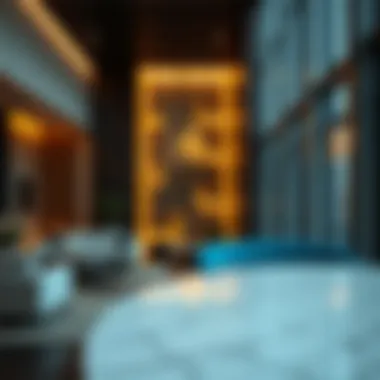
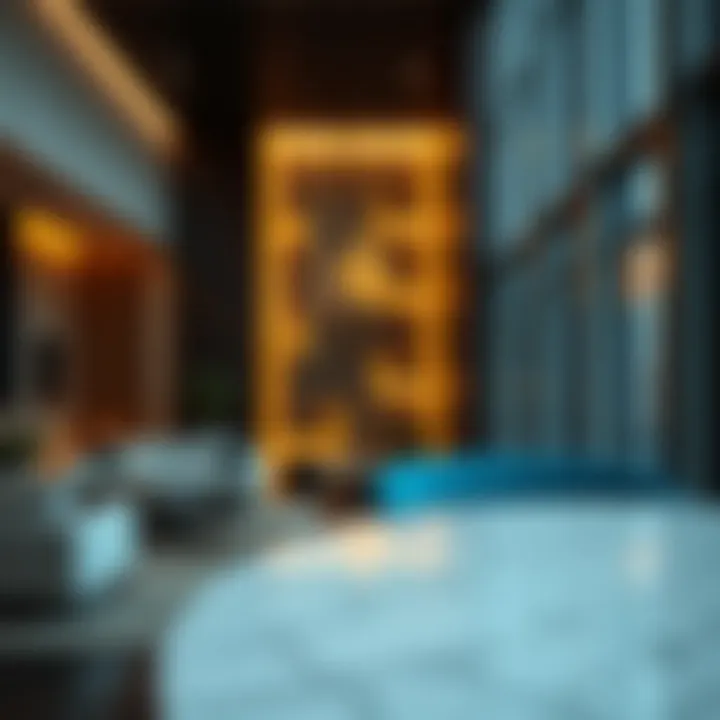
Economic Implications
The economic implications of the Tiger Building in Dubai extend far beyond mere aesthetics or architectural boldness. This section explores the notable influence the structure has on the local economy, involving its impacts on real estate, investment opportunities, and more. Understanding this aspect provides insights into how landmark buildings shape financial landscapes and drive urban development.
Impact on Local Real Estate Market
The construction of the Tiger Building has undeniably stirred the local real estate market, acting as a barometer for growth. Since its establishment, property values in the surrounding areas have seen remarkable appreciation. Investors and homeowners alike are taking a keen interest in the vicinity, drawn by the allure of living close to an emblematic development.
Key reasons for this surge include:
- Increased Visibility: Being a standout structure, it enhances the overall charm of the area, making it a coveted spot.
- Enhanced Infrastructure: The development prompted improvements in local transport and services, creating a more favorable environment for businesses and families.
- Cultural Appeal: As it embodies a unique architectural style, it attracts tourists and residents seeking cultural experiences, thereby driving demand.
The heightened demand for both residential and commercial properties stems from an intrinsic psychological factor—people naturally gravitate towards aesthetically pleasing and culturally significant areas. The Tiger Building serves as a catalyst, elevating the desirability of neighboring properties and potentially leading to a gentrification effect, which is common in urban settings where iconic buildings are located.
Investor Opportunities
With the Tiger Building showcasing a blend of innovation and grandeur, it opens a treasure trove of investment opportunities. Investors, both local and international, are eager to latch onto the momentum generated by this architectural marvel. Here are some compelling opportunities that arise due to this landmark:
- Commercial Leasing: Businesses are drawn to secure prime real estate around the Tiger Building, leading to high demand for retail spaces, offices, and services that cater to a diverse clientele.
- Residential Developments: Real estate developers are seizing opportunities for new constructions in the vicinity, anticipating a wave of people wanting to call this area home, enhancing the overall community experience.
- Tourism-Driven Investments: Given the building's appeal as a tourist attraction, investors can capitalize on hospitality ventures such as hotels, restaurants, and entertainment venues that cater directly to visitors.
Moreover, speculative property acquisitions in this region have seen varied success, showing that while some investors reap considerable rewards, others must exercise caution.
"Understanding trends in local economies is key to tapping into the potential that landmark structures like the Tiger Building offer."
In summary, the Tiger Building does much more than just stand tall; it actively shapes the future of Dubai's economic landscape. From influencing the local real estate market to presenting numerous investor opportunities, this architectural gem is a focal point for growth and development, warranting close monitoring by savvy investors and stakeholders.
Cultural Significance
The cultural significance of the Tiger Building in Dubai goes beyond its striking visual appeal. It serves as a beacon in the ever-evolving urban landscape, reflecting not just architectural prowess but also the identity and aspirations of the UAE. The building encapsulates elements that resonate deeply with both locals and expatriates, embodying a blend of tradition and innovation that is central to Dubai’s ethos.
Symbolism in Architecture
At its core, the Tiger Building is symbolic. The design and layout elegantly pay homage to the rich heritage of Dubai, while simultaneously embracing modernity. Its silhouette resembles the shape of a tiger, representing strength and power, qualities revered in Arabic culture. This unique form might be interpreted as a nod to the dynamic nature of the city itself — one that is always ready to pounce on opportunities or tackle challenges head-on.
Moreover, the building employs motifs that draw from Islamic art, subtly integrating traditional patterns in its façade and interiors. This not only showcases artistic heritage but also fosters a sense of belonging among those who enter, inspiring a shared cultural identity. It’s as if the walls speak volumes; they narrate stories of the past while looking towards an ambitious future.
Community Interaction Spaces
The Tiger Building’s design incorporates various community interaction spaces, emphasizing social connectivity in an area often bustling with activity. These spaces are not mere afterthoughts; they have been strategically placed to cultivate a sense of togetherness. Amenities such as open-air lounges, multi-purpose event areas, and retail sections encourage people to gather, discuss, and exchange ideas.
- Open Air Lounges: These spaces allow for casual meet-ups, fostering informal gatherings that enhance community bonds.
- Event Venues: Regular exhibitions and cultural events hosted within the building create opportunities for engagement, attracting a diverse audience.
- Retail Opportunities: Shops and cafes provide locals and visitors alike with a chance to unwind and socialize, bridging gaps among different demographics.
Ultimately, these interaction spaces are invaluable. They support the idea that architecture should not only be functional but should also deepen connections within the community. Through thoughtful design, the Tiger Building stands as a catalyst for cultural interchange, bridging the past and future, the local and global, all while remaining firmly rooted in the vibrant tapestry of Dubai’s community.
"Architecture is a visual art, and the buildings speak for themselves." - Julia Morgan
In summary, this building's cultural significance lies in ** its ability to resonate with a diverse populace**, creating a physical manifestation of shared aspirations and values. The interplay of symbolism in architecture combined with intentional community interaction spaces not only enriches the user experience but also elevates the narrative of Dubai itself.
Technological Innovations
In the realm of modern architecture, technological innovations play a pivotal role in redefining how buildings are designed, constructed, and managed. The Tiger Building stands as a testament to the transformative power of these advancements. These innovations not only enhance the functionality of the structure but also contribute towards sustainability and user experience, reflecting the fast-paced urban lifestyle of Dubai.
Technological innovations encompass a range of elements, including smart building features and sophisticated building management systems. As investors and homeowners seek properties that combine luxury with practicality, understanding the importance of these technologies becomes essential for informed decision-making.
Smart Building Features
Smart building features are revolutionizing the way occupants interact with their environment. In the Tiger Building, an array of technologies enable automation and enhanced control over building systems.
- Intelligent Lighting Systems: These adjust based on occupancy and natural light levels. Occupants enjoy optimal lighting while energy is conserved, thus reducing costs.
- Advanced HVAC Controls: The heating, ventilation, and air conditioning systems are smartly managed to optimize air flow and temperature, ensuring comfort without wasting energy.
- Occupancy Sensors: Integrated into various spaces, these sensors provide data that can guide maintenance schedules and lower energy use when areas are not occupied.
"The absence of clutter and complexity in the building's technological setup ensures comfort while meeting the demands of its users."


Integrating such smart features does not only increase comfort but also boosts the building's overall efficiency. This could be beneficial for investors looking to attract tenants who appreciate modern living environments.
Building Management Systems
Building management systems (BMS) serve as the backbone of the Tiger Building, consolidating various operation functions into a unified platform. This centralization improves oversight and control.
- Monitoring and Control Systems: With BMS, operators can monitor the performance of various subsystems, such as lighting and HVAC. This ability to oversee multiple systems effectively ensures immediate responses for maintenance and repairs.
- Data Analytics: BMS provides detailed insights based on data collected from different sensors. This data helps in predictive maintenance, enhancing the lifespan of building systems.
- User Interfaces: These systems come equipped with user-friendly interfaces, allowing for ease of operation by building managers. The simplicity of these interfaces reduces training time and supports operational efficiency.
Investors are likely to see the long-term financial benefits of such management systems, given their potential to reduce operational costs through efficient resource management and lower energy consumption.
Comparative Analysis
The comparative analysis of Tiger Building in the context of Dubai’s skyline is pivotal. This building does not exist in isolation; rather, it's a thread woven into the intricate fabric of the emirate’s architectural ambitions and urban identity. By evaluating Tiger Building against other iconic structures in Dubai, we gain insights into its significance, functionality, and design choices. It helps highlight the contrasts and similarities that define Dubai's architectural narrative, showcasing how each building contributes uniquely to the city’s allure.
Comparing to Other Landmark Structures in Dubai
When you take a stroll through Dubai, it's like walking through a gallery of modern architecture, with each building telling its own story. Let's examine how Tiger Building compares to other renowned structures, such as the Burj Khalifa and the Dubai Mall.
- Burj Khalifa: This towering titan is not just a skyscraper but a symbol of human ambition. Tiger Building, while not vying for the tallest title, offers keen insights into sustainability that even Burj Khalifa is striving to embrace.
- Dubai Mall: This massive retail space attracted millions and revolutionized shopping. Here, Tiger Building steps back to allow for community interaction, proving that it values more than just commerce; it prioritizes people.
In essence, Tiger Building embodies the spirit of inclusivity found in many of Dubai’s architectural endeavors, but it carves its own niche by fostering a sense of place among the bustling dynamics of a high-energy metropolis.
Lessons from Global Architectural Trends
As we zoom out and take a look at global trends, it's clear that architecture is undergoing a transformation, much like a butterfly coming out of a chrysalis. Across the world, there's a push towards sustainability, digitization, and integration of nature with built environments. Tiger Building reflects these valuable lessons, showcasing strategies that could very well shape the future of architecture globally:
- Sustainability: Many structures now use materials that minimize environmental impacts. Tiger Building taps into this with its resource-efficient designs, mirroring advances seen in eco-friendly buildings around the world.
- Smart Cities: With technology evolving rapidly, Tiger Building’s construction incorporates smart systems, aligning with the trend towards creating not just buildings, but intelligent environments.
- Cultural Resonance: Global architecture is increasingly focused on representing local cultures. Tiger Building draws inspiration from UAE heritage while embracing modernity, making it a true product of its environment.
In summary, comparative analysis not only highlights how Tiger Building stands amidst towering giants, but also spins a narrative that resonates with current architectural trends worldwide. This understanding is essential for potential investors and homebuyers who seek to navigate this dynamic market.
Future Prospects
Exploring the future prospects of the Tiger Building in Dubai reveals a fascinating tapestry of potential and anticipation. As Dubai continues to position itself as a cutting-edge city in the global architectural landscape, the Tiger Building stands as a significant player in redefining urban living and investment options. In focusing on specific elements such as upcoming developments and the ever-evolving urban framework, we can grasp the myriad benefits and considerations surrounding this architectural jewel.
Potential Developments
The future holds promise for the Tiger Building, particularly through planned expansions and enhancements that aim to boost its functionality and appeal. Key potential developments include:
- Vertical Expansion: Adding additional floors to accommodate more businesses or residential spaces could transform the building further into a multi-purpose hub.
- Integration of Smart Technologies: Leveraging advancements in building technologies, the incorporation of smart home systems and energy-efficient appliances can enhance sustainability, making the building more attractive to eco-conscious investors.
- Community Spaces: Plans to create more community interaction zones within the building can foster a sense of belonging, enhancing the living and working experience for residents and employees alike.
These developments not only stir interest among potential investors but also provide an avenue for the building to adapt to the changing demands of urban life.
Evolving Urban Landscapes
As Dubai's urban landscape continues to evolve, the importance of thoughtful architectural designs cannot be overemphasized. The Tiger Building symbolizes resilience and innovation amidst competing structures. This evolution can be understood through several lenses:
- Cultural Integration: The integration of cultural elements in modern design helps in maintaining the local heritage while embracing contemporary needs.
- Sustainable Living: With a global shift towards sustainability, the Tiger Building can set a benchmark, influencing other constructions to adopt eco-friendly practices.
- Lifestyle Adaptation: As the needs of expatriates, homeowners, and local businesses change, the building's flexibility to adapt to various lifestyles will be crucial. This ongoing evolution benefits not only the residents but also enhances the overall attractiveness of the area to new businesses and tourists.
"The future of urban living hinges on how well we adapt our spaces to meet the needs of the communities they serve."
Finale
The conclusion serves as a capstone to the extensive journey we’ve undertaken through the multifaceted aspects of the Tiger Building in Dubai. This section is not merely a wrap-up; it crystallizes the core insights while addressing the broader implications of this architectural marvel. Key elements like sustainability, the integration of technology, and the building's impact on the local real estate landscape deserve particular emphasis here.
In essence, one must reflect on how the Tiger Building exemplifies modern architectural progress while embracing the rich cultural narrative of Dubai. It stands as a landmark that not only enhances the skyline but also exemplifies sustainability in design. For investors, its innovative features may offer tantalizing opportunities, whereas for expatriates and homeowners, the sense of community interaction it fosters is equally paramount. The economic ripple effect entwined with such a structure cannot be ignored; it stimulates not just the immediate neighborhood but the entire metropolis.
Being equipped with this knowledge, potential investors or future residents can make informed decisions about their involvement in Dubai’s ever-evolving architectural landscape. Ultimately, the depth of consideration around the Tiger Building's location, design, and potential future adaptations renders it worthy of both admiration and serious investment.
Summary of Key Insights
- Architectural Significance: The Tiger Building's design reflects a contemporary aesthetic while paying homage to local traditions.
- Economic Impact: As a player in Dubai’s real estate market, it drives demand and enhances property values in the vicinity.
- Community Interaction: Emphasizes spaces designed for fostering connections among residents and visitors alike.
- Technological Innovation: Integrates smart building technologies that contribute to energy efficiency and ease of management.
Final Thoughts on Tiger Building's Role
As we draw our analysis to a close, it is crucial to contemplate the Tiger Building's role not just as a physical structure, but as a symbol of progress and innovation in Dubai. The building challenges conventional notions of what a skyscraper can represent and continually evolves alongside the city it inhabits. Furthermore, it acts as an anchor point, attracting both global investors and local families
This bridging of aspirations encapsulates what Dubai strives for— a fusion of modernity with heritage. Those who choose to engage with this building, whether as investors or community members, embark on a journey that goes beyond mere acquisition or residency. They become part of a narrative that showcases how architecture can shape urban identity, contribute to the economy, and foster communal ties. In short, the Tiger Building is much more than just stone and steel; it is a gateway to understanding the future of urban living in one of the world's most dynamic cities.


